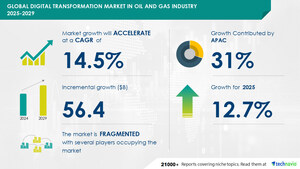NEW YORK, Sept. 18, 2024 /PRNewswire/ -- Report on how AI is driving market transformation- The global lignocellulosic feedstock-based biofuel market size is estimated to grow by USD 33.6 billion from 2024-2028, according to Technavio. The market is estimated to grow at a CAGR of 50.35% during the forecast period. Non-cropland affecting nature of lignocellulosic feedstock is driving market growth, with a trend towards rising ethanol blending rate targets. However, complex and costly conversion process poses a challenge. Key market players include Aemetis Inc., ALTRET GREENFUELS Ltd, BDI BioEnergy International GmbH, Blue Biofuels Inc., Borregaard ASA, China Petrochemical Corp., Clariant International Ltd., COSAN S.A., DuPont de Nemours Inc., ENERKEM Inc., Genera Inc., Gevo Inc., GranBio Investimentos SA, New Energy Blue LLC, Novozymes AS, and VERBIO Vereinigte BioEnergie AG.
AI-Powered Market Evolution Insights. Our comprehensive market report ready with the latest trends, growth opportunities, and strategic analysis- View your snapshot now
Forecast period |
2024-2028 |
Base Year |
2023 |
Historic Data |
2018 - 2022 |
Segment Covered |
Conversion Process (Biochemical and Thermochemical), Application (Automotive, Aviation, and Others), and Geography (North America, South America, Europe, APAC, and Middle East and Africa) |
Region Covered |
North America, South America, Europe, APAC, and Middle East and Africa |
Key companies profiled |
Aemetis Inc., ALTRET GREENFUELS Ltd, BDI BioEnergy International GmbH, Blue Biofuels Inc., Borregaard ASA, China Petrochemical Corp., Clariant International Ltd., COSAN S.A., DuPont de Nemours Inc., ENERKEM Inc., Genera Inc., Gevo Inc., GranBio Investimentos SA, New Energy Blue LLC, Novozymes AS, and VERBIO Vereinigte BioEnergie AG |
The transportation sector's increasing greenhouse gas (GHG) emissions have prompted governments worldwide to set ambitious emission reduction targets. To address this issue, many countries are mandating the use of biofuels by blending them with gasoline. China, the world's largest transport fuel market, has recently increased ethanol blending from six to all provinces to reduce air pollution, fossil fuel consumption, and improve energy security. Similarly, several European Union (EU) countries are adopting renewable ethanol to meet renewable and climate targets. These rising ethanol blending rate targets will boost the demand for bioethanol, primarily derived from lignocellulosic feedstocks, and drive the global lignocellulosic feedstock-based biofuel market growth during the forecast period.
The Lignocellulosic Feedstock-Based Biofuel market is on the rise, with trends including the use of Sida hermaphrodita from the Mallow family, halophytes, and feedstocks like Desmostachya bipinnata, Phragmites karka, Panicum turgidum, Brachypodium, and more. Plant Biotechnology is a key driver, focusing on non-cropland sources. The adoption of bioethanol as a transport fuel reduces GHG emissions, with conversion processes using both biochemical and thermochemical methods. Ethanol blending is increasing, making second-generation biofuels a winning imperative. Integrated waste management is essential, and release studies on market synthesis, analyzing multiple parameters like profit, pricing, promotions, and industry influencers. Aviation is a growing sector, with cost and product pricing influenced by political factors, social scenarios, regulations, and spending. Leading and emerging companies expand their company regional and industry footprints, striving for scalability and innovation.
Insights on how AI is driving innovation, efficiency, and market growth- Request Sample!
• Lignocellulosic feedstocks, composed of lignin, hemicellulose, and cellulose, are used to produce biofuels, primarily bioethanol. The production process involves pretreatment, enzymatic hydrolysis, fermentation, and separation. However, the conversion of biomass to sugars is a significant challenge due to the tightly packed cellulose microfibrils and the presence of lignin and hemicelluloses. This limits access of polysaccharides to enzymes during hydrolysis. In fermentation, organisms struggle to efficiently convert pentose sugars, such as arabinose and xylose, and hexoses, including glucose, mannose, and galactose, to ethanol. Other challenges include low microorganism ethanol tolerance, low reaction rates, and incomplete pentose conversion. Commercial production of cellulosic ethanol remains complex and costly due to economies of scale lower than fossil fuels, hindering market growth.
• The Lignocellulosic Feedstock-Based Biofuel Market is experiencing significant growth due to the increasing demand for renewable and sustainable energy sources. However, several challenges persist in this sector. Company benchmarking is crucial to remain competitive, with key players including Mendel Biotechnology, BP Biofuels, Generac Energy, and others. Lignocellulosic feedstocks, derived from cellulose and lignin in biomass, pose unique challenges. These include the complex structure of cellulose and lignin, requiring advanced thermochemical conversion processes like pyrolysis, torrefaction, and gasification. Feedstocks like wood, short rotation coppice, energy grasses, reeds, and various types of miscanthus (Miscanthus giganteus, Miscanthus sinensis) are under exploration. Drop-in biofuels, such as cellulosic ethanol, offer GHG efficiency advantages over traditional diesel. Utilizing marginal lands, including riparian and wetlands, is essential to minimize soil erosion and reduce the competition with food production. Saline soils and water also pose challenges, with feedstocks like reed canary grass (Phalaris arundinacea), giant reedgrass (Arundo donax), and various types of grasses (Giant King Grass, Napier Grass, Elephant Grass, Pennisetum purpureum) showing potential. Plant breeding and biotechnology play a vital role in enhancing feedstock productivity and sustainability. The Poaceae family, which includes switchgrass and willow, is a focus area for research and development. In conclusion, the Lignocellulosic Feedstock-Based Biofuel Market presents numerous opportunities and challenges, requiring continuous innovation and collaboration to overcome hurdles and drive growth.
Insights into how AI is reshaping industries and driving growth- Download a Sample Report
This lignocellulosic feedstock-based biofuel market report extensively covers market segmentation by
- Conversion Process
- 1.1 Biochemical
- 1.2 Thermochemical
- Application
- 2.1 Automotive
- 2.2 Aviation
- 2.3 Others
- Geography
- 3.1 North America
- 3.2 South America
- 3.3 Europe
- 3.4 APAC
- 3.5 Middle East and Africa
1.1 Biochemical- The lignocellulosic feedstock-based biofuel market is experiencing significant growth due to increasing demand for renewable energy sources. This market primarily focuses on converting non-food biomass, such as agricultural waste and wood chips, into biofuels. Key players in this industry include DuPont, Abengoa, and POET, who are investing heavily in research and development to improve production efficiency and reduce costs. Government initiatives and policies supporting renewable energy are further boosting market growth.
Download complimentary Sample Report to gain insights into AI's impact on market dynamics, emerging trends, and future opportunities- including forecast (2024-2028) and historic data (2018 - 2022)
The lignocellulosic feedstock-based biofuel market refers to the production of biofuels from biomass sources, specifically those rich in cellulose, lignin, and other complex carbohydrates. These feedstocks include wood, short rotation coppice, energy grasses, reeds, and other agricultural residues. The market for these biofuels, which include drop-in biofuels for aviation and diesel, has gained traction due to the adoption of bioethanol as a transport fuel and the potential to reduce greenhouse gas emissions. The cost-effective conversion process involves both biochemical and thermochemical methods, which break down the lignocellulosic material into simpler sugars for fermentation or produce syngas for the production of biofuels through Fischer-Tropsch synthesis. The nature of lignocellulosic feedstocks presents challenges in the conversion process, but ongoing research and technological advancements continue to drive market growth. The biofuel market for lignocellulosic feedstocks is expected to expand significantly as the demand for sustainable and low-carbon transport fuels continues to increase.
The Lignocellulosic Feedstock-Based Biofuel Market is a rapidly growing sector focused on producing biofuels from non-food sources, such as cellulose, lignin, wood, short rotation coppice, energy grasses, reeds, and other plant materials. The market is driven by the need to reduce greenhouse gas (GHG) emissions in the transport sector and the availability of marginal lands for feedstock production. Cost is a significant factor in the market, as the conversion process for lignocellulosic feedstocks is currently more expensive than that of traditional corn-based ethanol. Product pricing and political factors also play a role, with regulations and government spending influencing the industry's growth. Winning imperatives for companies include scalability, innovation, and leading and emerging technologies such as thermocellulosic conversion, cellulosic ethanol, pyrolysis, torrefaction, gasification, plant breeding, and biotechnology. Companies with a strong regional and industry footprint, such as Mendel Biotechnology, BP Biofuels, Genera Energy, and those focusing on Miscanthus species like Miscanthus giganteus and Miscanthus sinensis, are at the forefront of this market. The market also includes various feedstocks, including halophytes, reed canary grass, and various grasses like Napier Grass, Elephant Grass, Pennisetum purpureum, and Poaceae family members. The use of non-cropland and adoption of bioethanol as a transport fuel is a key trend in the market, with second-generation biofuels and integrated waste management playing essential roles in its future development. This market report, published by a reputable provides in-depth analysis of the market, including company benchmarking, market size, growth trends, and future outlook.
1 Executive Summary
2 Market Landscape
3 Market Sizing
4 Historic Market Size
5 Five Forces Analysis
6 Market Segmentation
- Conversion Process
- Biochemical
- Thermochemical
- Application
- Automotive
- Aviation
- Others
- Geography
- North America
- South America
- Europe
- APAC
- Middle East And Africa
7 Customer Landscape
8 Geographic Landscape
9 Drivers, Challenges, and Trends
10 Company Landscape
11 Company Analysis
12 Appendix
Technavio is a leading global technology research and advisory company. Their research and analysis focuses on emerging market trends and provides actionable insights to help businesses identify market opportunities and develop effective strategies to optimize their market positions.
With over 500 specialized analysts, Technavio's report library consists of more than 17,000 reports and counting, covering 800 technologies, spanning across 50 countries. Their client base consists of enterprises of all sizes, including more than 100 Fortune 500 companies. This growing client base relies on Technavio's comprehensive coverage, extensive research, and actionable market insights to identify opportunities in existing and potential markets and assess their competitive positions within changing market scenarios.
Technavio Research
Jesse Maida
Media & Marketing Executive
US: +1 844 364 1100
UK: +44 203 893 3200
Email: [email protected]
Website: www.technavio.com/
SOURCE Technavio

WANT YOUR COMPANY'S NEWS FEATURED ON PRNEWSWIRE.COM?
Newsrooms &
Influencers
Digital Media
Outlets
Journalists
Opted In




Share this article